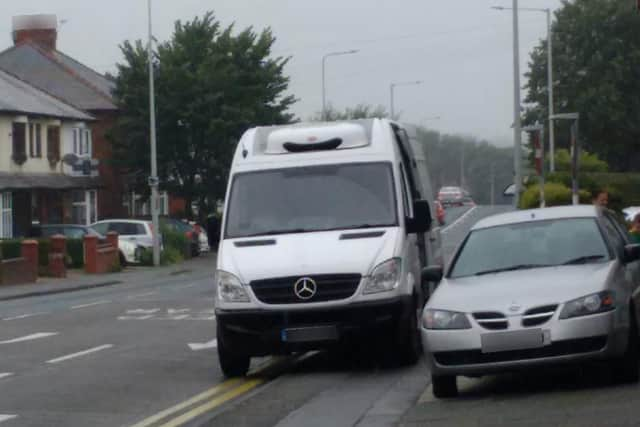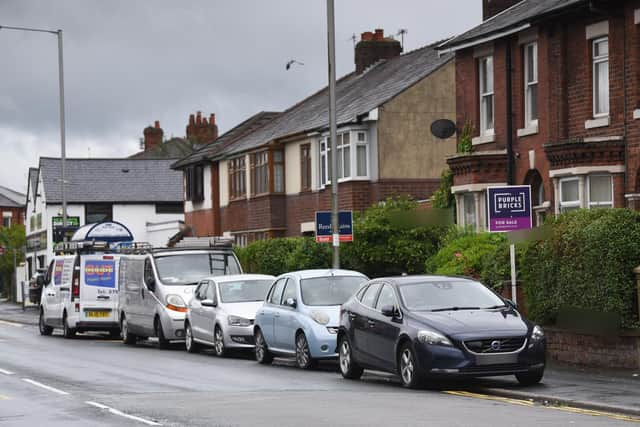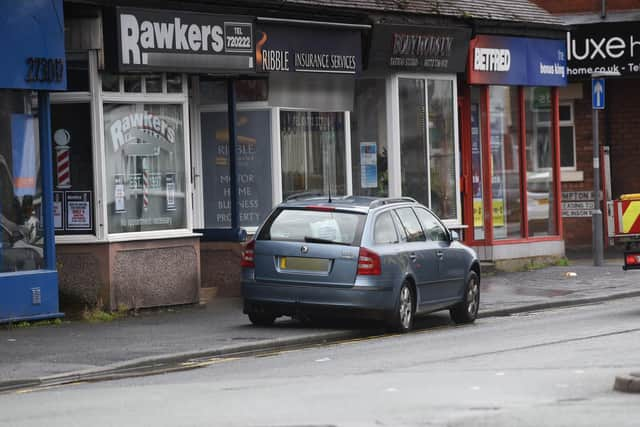Plan to curb Preston's pavement parking problem
and live on Freeview channel 276
Currently, only the police can take action against drivers who block footpaths – unless there are already parking restrictions in force in the road itself.
Cabinet member for highways Keith Iddon said that he wanted to see the offence of obstructing the highway decriminalised. That would mean the authority’s own parking enforcement teams could issue fixed penalty notices in circumstances where the practice was causing difficulty for pedestrians.
Advertisement
Hide AdAdvertisement
Hide AdHowever, County Cllr Iddon told a meeting of the full council that he did not want to see a blanket ban on pavement parking in Lancashire, as has existed in London since 1974.


“It’s a very important issue, [because] we are a very diverse county. In London, the city has adapted to [the ban] – in Lancashire, we aren’t that fortunate,” he said.
Like many other parts of the country, Lancashire has some streets so narrow that if drivers always had to park flat on the road, other vehicles would not be able to pass – effectively creating parking restrictions where none currently exist.
One Preston resident says that action cannot come soon enough to force cars off the footways at what she describes as “one of the worst junctions in the city”.


Advertisement
Hide AdAdvertisement
Hide AdMaria – who did not want her surname published – lives close to the intersection of Blackpool Road, Tulketh Brow and Woodplumpton Road and believes that pavement parkers pose a particular risk in the area.
“People stop in quite stunningly dangerous places – it’s astonishing to see where they will pull up.
“In some cases, they park fully on the pavement and people are having to walk in the road close to a dangerous junction. If you have a pushchair with you or are in a wheelchair yourself, then you are so vulnerable.
“Sometimes it’s just one car that causes the problem, but other times it’s a combination of them – one parks in one place and then another slightly staggers themselves, while pedestrians are left trying to weave through.


Advertisement
Hide AdAdvertisement
Hide Ad“Occasionally, you’ll say something to them, like ‘Did you have to park there?’ – but you just get abuse in return,” Maria said.
The presence of yellow lines on all approaches to the junction – known locally as Lane Ends – means that the county council already has enforcement powers against drivers who park on the pavement in the area. The police would not be required to get involved to prove any obstruction offence, because the parking restrictions apply to both the road and the pavement.
County Hall says that, since 1st June, its parking patrols have visited Blackpool Road 113 times and issued 14 tickets, Tulketh Brow on 14 occasions, handing out three tickets, and Woodplumpton Road four times, none of which has resulted in a penalty being issued.
However, under the existing rules, the authority has been powerless to act in another area of Ashton-on-Ribble without yellow lines, where one resident who is registered blind told the Lancashire Post that he had sometimes been forced into the road to get past cars parked on the pavements.
Advertisement
Hide AdAdvertisement
Hide AdThe man, who did not want to be named, said that the problem had been compounded by shrubbery overhanging the footpaths on roads including Garden Walk and Wellington Road.
“I actually have some sympathy with the drivers, because they have got no choice but to pull half onto the pavement on some roads, because they’d be blocking the way otherwise.
“But homeowners need to be aware of the impact that trees and bushes at the front of their houses can have if they encroach onto the street – especially for anybody with sight problems,” said the man.
He added that introducing one-way systems on some side streets could be a way of clearing cars from the pavements by providing them with more room to keep all four wheels on the carriageway.
Advertisement
Hide AdAdvertisement
Hide AdAfter being alerted to the problem, the county council contacted households in the area with overgrown hedges and asked for them to be cut back – with many having now done so.
Meanwhile, just half a mile away, Powis Road perfectly illustrates the confusion over the current enforcement arrangements when it comes to pavement parking.
The stretch of the road closest to the junction with Tulketh Road is painted with double yellow lines on one side, putting it in the scope of County Hall’s parking patrols – while the rest of the route is free of on-street restrictions, meaning any pavement parkers can only be dealt with by the police if they are causing an obstruction.
However, according to one resident, there is no such distinction in the danger that all pavement parking causes to pedestrians.
Advertisement
Hide AdAdvertisement
Hide Ad“Particularly once it is dark of an evening during winter and people have returned home from work in their cars, you can see pedestrians having to walk just on the edge of the kerb or actually in the gutter, because they can’t get past on the pavement.
“There are sometimes about eight vehicles at a time parked on the side with the double yellow lines and there are a large number of trees on Powis Road, so people aren’t always visible. Although it’s a 20mph road, people use it as a rat-run, sometimes getting to over 40mph,” said the man, who did not want to be identified.
He added that it would make more sense for parking patrols to be carried out after 5pm in order to enforce those restrictions that are under the county council’s control – but a Freedom of Information request he submitted revealed that the road received no out-of-hours visits between October and December last year, with neighbouring Tulketh Road getting just one.
A spokesperson for Lancashire County Council said that, since 1st June, Powis Road had been visited by parking patrols 26 times during the daytime, with five tickets issued.
Advertisement
Hide AdAdvertisement
Hide AdHe added: “We carry out parking enforcement during the evenings on a targeted basis in response to intelligence received from the public, councillors, and businesses about problem parking.
“We have not carried out any evening enforcement since the start of the Covid-19 lockdown in recognition that many people have not been working, or have been working from home, resulting in more people needing to park in residential areas throughout the day.
“However, we will be resuming targeted evening enforcement from the start of August and would encourage people to let us know about specific issues so that we can target our limited resources as effectively and efficiently as possible.”
The decriminalisation of highway obstruction, as favoured by the county council, was another of the transport select committee’s recommendations, because parking offences are “not a priority for the police”.
Advertisement
Hide AdAdvertisement
Hide AdCounty Cllr Gillian Oliver, who raised the issue at full council after receiving numerous complaints from residents in her Preston South West division, supported the move for shifting power and responsibility for enforcement of pavement parking rules to County Hall.
“It should be a matter for councils, because it is difficult for the police to enforce something which many people probably won’t realise is a criminal offence.
“However, a change in legislation will take time and so it would be good to see the police and county council to team up to do something in the meantime,” said County Cllr Oliver.
Lancashire Constabulary was approached for comment.
WHAT THE LAW SAYS
The Highway Code states that drivers must not park on the pavement in London and should not do it elsewhere unless signs specifically permit it.
Advertisement
Hide AdAdvertisement
Hide AdHowever, according to the RAC, the use of the phrase “should not” for areas outside the capital introduces a level of discretion for places like Lancashire.
Motorists also need to be aware of a separate rule which makes obstruction of the highway – including footpaths – an offence. Any breach can be enforced only by the police, not traffic wardens.
However, local authority parking patrols can issue fixed penalty notices for pavement parking where it occurs alongside existing restrictions on parking in the road itself. Councils can acquire powers over pavement parking even in areas without on-street restrictions if they issue a traffic regulation order (TRO) covering a particular stretch of road. However, the TRO process is often lengthy and requires public consultation.
The RAC website advises drivers to use “common sense” if they have no option but to park on the pavement.
Advertisement
Hide AdAdvertisement
Hide Ad“If you are parking along a narrow road, where parking wholly on the road would stop other cars, and particularly emergency vehicles, from getting through, then it is a sensible option to park partially on a pavement, providing there are no parking restrictions and providing you are not blocking a wheelchair user or pram from using the pavement.
“If there are restrictions, or your parking would cause wheelchair users or people with prams to have to walk into the road, then you should find somewhere else to park,” the motoring organisation says.
Driving on the pavement is also against the law – even if it is with the intention of parking – unless it is to access a driveway via a dropped kerb.
MPs CALL FOR ‘URGENT’ SOLUTION TO PAVEMENT PARKING PROBLEMS
A report by the House of Commons transport select committee last year recommended an outright ban on pavement parking in all areas of England, with certain local exemptions being permitted – something on which the government has since said it will hold a consultation.
Advertisement
Hide AdAdvertisement
Hide AdMembers of the committee welcomed the move, but their report said ministers should move quickly to tackle a problem that has “a considerable impact on people’s lives and their ability to safely leave their homes”.
“We have received evidence from people with both visual and mobility impairments, and those who care for others – including children – about how they are affected by pavement parking. People are at risk of social isolation if they feel unable to leave their homes safely or are physically prevented from doing so.
“While pavement parking can be a necessity in some areas, it should not be allowed to happen where it has a significant adverse impact on people’s lives,” the report concluded.